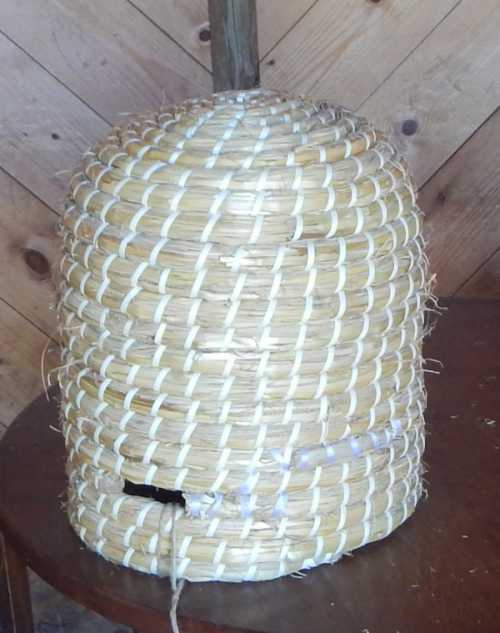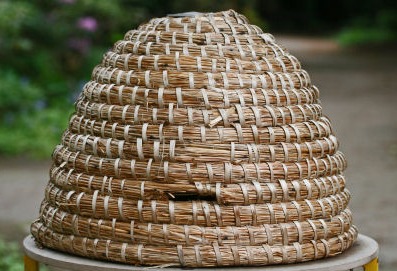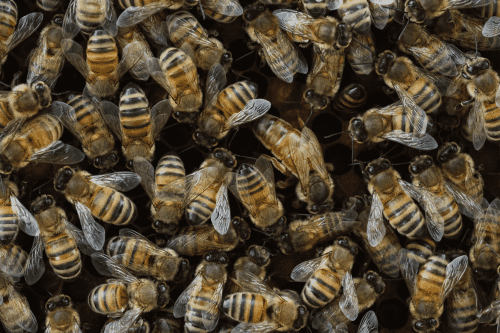What Are Skeps?
Skeps are large straw baskets that were traditionally used for beekeeping.
Read on to learn more about the use of skeps.
The Meaning of 'Skep'
Thomas D. Seeley, author of The Lives of Bees1 notes the word skep comes from an Old Norde word: skeppa, which translates as 'a big basket'.
Seeley states that the word 'skep':
"... evidently entered the English language after the Vikings began raiding and settling in England, starting around 800 CE".
 A skep featured in a display at Erddig, in Wales UK.
A skep featured in a display at Erddig, in Wales UK.Skeps were particularly used in beekeeping in Europe, and were made from woven rushes and were coated with clay and cow dung, but later were made simply with coiled straw1.
They were mostly kept in a sheltered spot, sometimes a 'bee bole', or perhaps kept on a covered shelf against a house wall.
Skeps were used both for capturing swarms and for housing the bees once caught.
'Swarm beekeeping'
Beekeeping with skeps was reliant on capturing plenty of swarms, and encouraging more swarms to be created in order to ensure a supply of hive products (honey and wax).
Skeps would be used to capture swarms, perhaps by holding the skep beneath a swarm on a tree branch and shaking the branch until the swarm fell into the skep.
The same inverted skep was then used to house honey bees. Along with the skep, a 'swarm catcher' might also be used.
Seeley notes:
"... beekeeping with skeps was often called swarm beekeeping because it depended on the production and hiving of swarms in early summer; the beekeepers then left the colonies alone to store honey from flows later in the summer and finally killed a certain portion of all the colonies to harvest their honey while leaving the rest alone to overwinter." ...
"Sometimes a swarm was caught by placing a swarm catcher - a tube of netting held in shape with several hoops - over the skep's entrance when a swarm began to issue. Some beekeepers knew that if they heard a sound like that of a bugle horn coming from a skep that had cast a prime swarm, they should expect an afterswarm to issue soon.
Beekeeping with skeps required abundant swarming, and beekeepers encouraged this by making their skeps small so that their colonies became crowded in late spring and early summer."

Sadly, both Seeley and Phil Chandler, author of The Barefoot Beekeeper, note that a certain proportion of bee colonies were destroyed in their entirety in order to harvest honey and wax, thanks to a lack of non-destructive means to do so.
The killing of honey bee colonies is avoided in modern western beekeeping practice. See: are bees killed for their honey?
How large were skeps?
Skeps were smaller in capacity than modern day bee hives.
According to Seeley, the recommended size of a skep in English beekeeping books from the 1500 - 1800, ranged from 9 to 36 litres (2.4 to 9.5 gallons), and were typically about 20 litres (5.3 gallons).
Are skeps used today?
Nowadays, most beekeepers use a variety of different bee hives, such as Langstroth, National or various forms of top bar hive rather than a skep to house the bees.
Skeps are, however, sometimes used purely for collecting swarms and a small minority of beekeepers in Europe may also still make use of skeps for housing bees2.
References
1. Thomas D. Seeley, The Lives of Bees: The Untold Story of the Honey Bee in the Wild, Publ. 2019, Princeton University Press, ISBN:9780691166766.
2. The Barefoot Beekeeper, Phil Chandler
If you found this page helpful or interesting, I'd really be grateful if you would share it with others - if not this page, perhaps another, such as Gardening For Bees.
Thank you so much :) .
